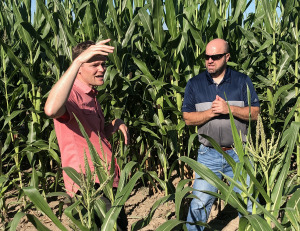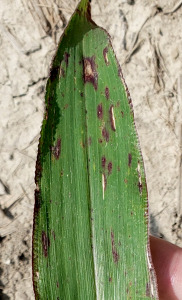Subscriber Benefit
As a subscriber you can listen to articles at work, in the car, or while you work out. Subscribe Now
Kyle Mohler, 38, grew up on his family’s farm just outside of Lebanon, where pretty much everything was done the traditional way. Though sometimes the “traditional way” just didn’t make sense to him.
That would lead him to launch the biotech startup Insignum AgTech four years ago. Insignum wants to develop corn (and other food plants) that can communicate with farmers using genetically implanted color codes.
The idea came about when Mohler, who possesses a bachelor’s in biochemistry and plant biology from Purdue University and a doctorate in plant biochemistry from the University of Edinburgh in Scotland, asked his father why he picked a somewhat arbitrary date each season to douse his entire corn crop with fungicides, whether it seemed to need it or not.
“I told him, ‘Why in the world would you do that? You won’t even know if the corn is actually infected at that time. It doesn’t make any sense,’” Mohler recalled.
Except that, given the information-poor environment in which his dad and all other farmers operate, it does make sense. Fungal infections can wipe out an entire corn crop, and by the time one notices the damage with the naked eye, it’s too late to intervene. So nuking everything prophylactically is the safest bet. Expensive and imprecise, but safe.
Which got Mohler thinking. Might there be some biology-based way for plants to signal that they face a fungal infection (or other dangers, such as insect predation) while there’s still time to do something about it?
Turns out there might be.
Mohler founded Insignum with the idea of rearranging bits of corn’s DNA, then inserting them into popular field-corn hybrids. This genetic material causes the plants to develop purple spots on their leaves during the onset of a fungal infection—spots that can be seen up close by the naked eye or by aerial drones or aircraft inspecting the field.

Besides catching fungal infections early enough for treatment, the process can target the portions of the crop that needed to be sprayed, reducing both costs and chemical use.
“I had always thought about starting a company,” Mohler said. “I thought biotechnology was kind of cool, but I didn’t really think that’s what I would do, because it takes such a big idea to make it work. But when I came up with this idea, I thought, ‘This is it.’”
He started working on the concept in 2019, doping out a business plan with the assistance of business incubator Purdue Innovates. The company’s funding includes $100,000 from the university-affiliated Purdue Ag-Celerator agriculture innovation fund.
“It was very difficult finding funding for a very simple idea like this,” Mohler said. “I didn’t have any experimental data in hand when I first started. I just said, ‘I’ve got this good idea, and I think it’s going to work.’ And I was lucky enough to find financial support during these difficult investment times.”
This spring, the company begins its fourth year of field tests—on the Mohler’s family farm—using corn embedded with the fungal infection marker. So far, it seems to be working as advertised. The new plant gene Insignum researchers have created isn’t brought in from some outside source but is simply a reconfigured portion of corn’s genetic code.
“We rearrange DNA that’s already in those plants,” Mohler said. “It enables that plant to use its pigments as a signaling system. Now, when the plants are in the very early stages of something that might damage [them], perhaps a fungal disease or insect attack, it sends a specific color change.”
Waiting game
But developing a biological system is slower than, say, software or hardware development. While software can be iterated and tested rapidly, alterations to corn genetics can be proven out only by growing a test batch through an entire season.
“The seed companies that we will initially sell to want to see it out in the field for at least a couple of years before they try it and take it to their farmers,” Mohler said. “They want to make sure they’ve tested it in all different kinds of scenarios, to know if it’s going to be robust and reliable for their farmers.”
Beck’s Hybrids in Atlanta is taking point on this effort. Insignum recently inked a deal with the company to collaborate on field-testing the purple-leaf trait in Beck’s proprietary corn varieties to evaluate their commercial viability.
“It’s a fascinating technology,” said Tom Koch, research manager at Beck’s. “I think it could offer a lot of value to the farmer if it indeed works.”
This planting season, Beck’s will offer its own extensive line of hybrid field-corn varieties to use as test beds for the new DNA. It has also provided space on its campus for Insignum’s offices.
“Beck’s has always tried to be on the cutting edge of research, but that doesn’t mean you have to create everything yourself,” Koch said. “But it does mean you have to be connected to those who are.”
If the new coding stands up to field tests, it could find its way into not just Beck’s offerings but also products of other hybrid corn developers. Which is exactly the approach Mohler wants to take. Insignum isn’t selling a corn hybrid, per se, but rather code that can be inserted into other people’s hybrids.
“We’re not going to sell corn directly to farmers,” he said. “We’re going to license seed companies who have excellent hybrids and genetics already. We’re just going to be one more gene in the seed that they sell.”
Precision agriculture

Insignum is part of a national trend toward precision agriculture, in which various technological means are employed for more accurate farming. That includes learning more about the health of crops so treatment can be targeted—ideally, dispensed by drones. What makes Insignum’s approach somewhat novel is that it’s one of the few companies attacking the precision ag market from the biological, rather than just the technological, perspective.
“Precision agriculture is really a broad-brush term, but this is definitely a piece that would fall under that,” said Ben Forsythe, director of sustainability and value creation at the Indiana Corn Marketing Council. “I think anytime you can know exactly when and where you have an issue, it gives you more options on what to do, saves money and allows you to be more efficient.”

David Masten, agronomy specialist at the Co-Alliance agricultural cooperative based in Indianapolis, is familiar with the product Insignum wants to bring to market and said it’s effectively “putting a canary in a coal mine.”
Most precision agriculture startups seem to concentrate on aspects like drone surveillance. When it comes to genetics, Mohler said, he’s pretty much alone—though he has heard of a company that inserts jellyfish DNA into corn. This causes the plant, if it’s stressed, to glow under infrared light like a Jimi Hendrix poster.
But the neat trick could pose regulatory hurdles that Insignum can dodge, since its approach reconfigures a plant’s existing DNA instead of inserting foreign material.
“The real advantage is that we won’t have any regulatory risks involved,” Mohler said. “So we can get through the regulator’s checks faster and easier. But a lot of places in the world still view gene editing in the same way they view older GMO technology.”
Next steps
Insignum has three employees, along with other folks who are more loosely associated with the company’s work. But Mohler hopes to grow the payroll if the company’s product tests well and starts making its way into crops. Insignum is also working on a remote sensing algorithm that would make the information the corn supplies more useful to farmers.
“Drones can pick them up, but it wouldn’t make a whole lot of sense for a human to look through thousands of drone images in order to pick up on color changes,” Mohler said. “So we’ll develop a computer vision algorithm that automatically detects those. The drone collects data and just spits out a report.”
After Insignum deploys its first, fungus-signaling corn, it plans to both expand its offerings for that crop (for instance, having the corn throw different colors for different problems) and to move into other plants.
Ironically, working with other crops might actually be easier. Corn, because of a genetic foible, manifests only spots of color on its leaves. Most other food plants (with the appropriate genetic manipulation) will readily switch entire leaves to purple or green or red, making problems much easier to spot.
“With corn, we still have something valuable that we can see,” Mohler said. “It’s just that we’re not going to be able to see it from a satellite.”
Crops that could get Insignum’s attention include everything from canola to tomatoes.
“We’re only working on corn right now, because we’ve tried to stay really lean and focused on one thing and not spreading ourselves too thin,” Mohler said. “But I think the technology will work differently in different crops, and we’ve got those lined up, and we’re ready to go once we raise some more funding and can hire some more scientists.”•
Please enable JavaScript to view this content.
